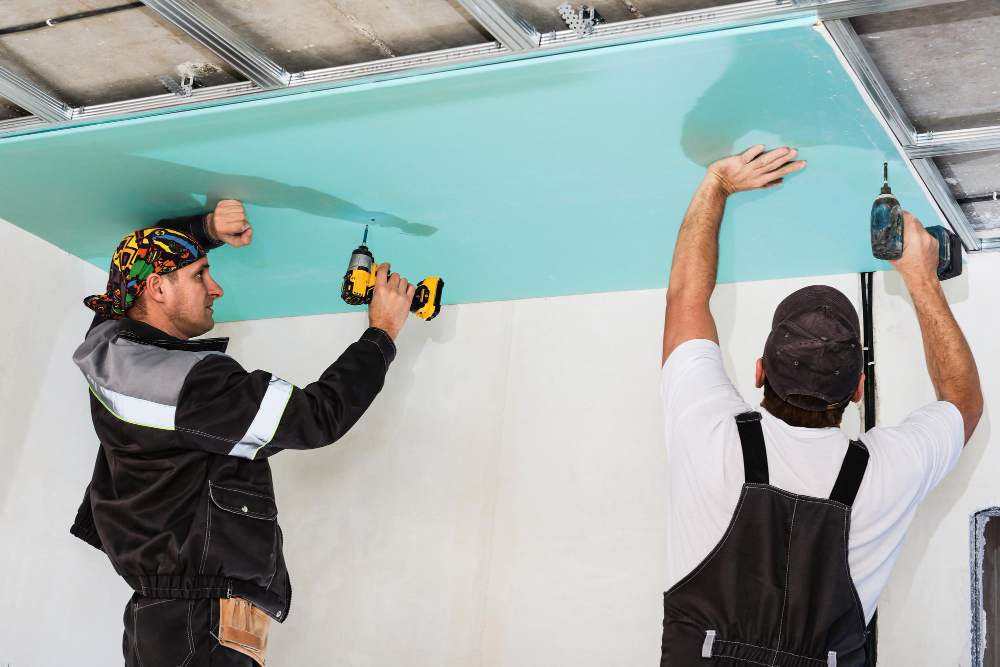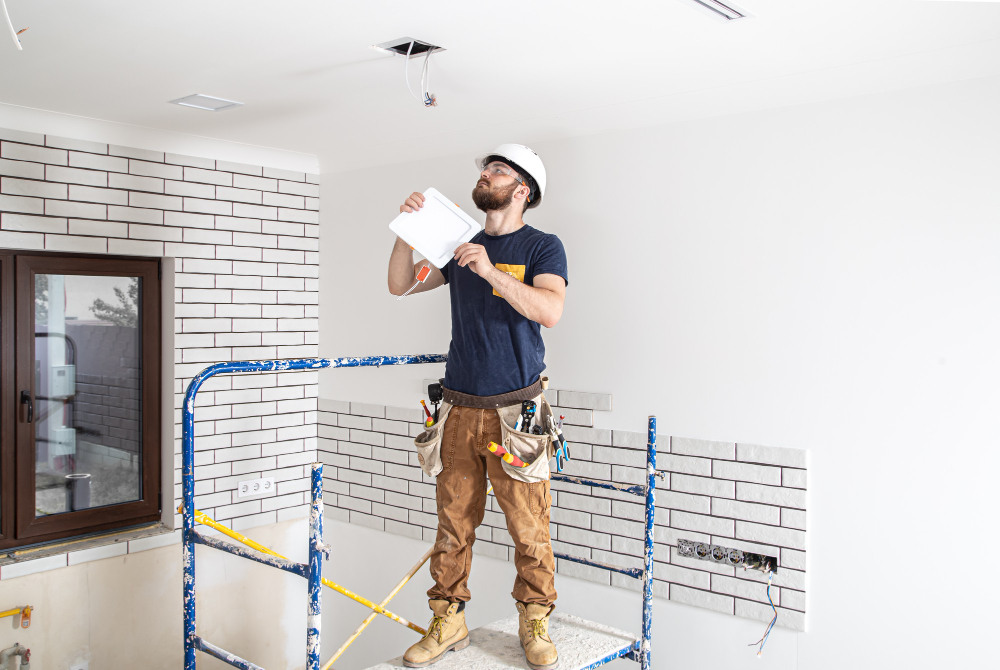Drywall installation is a key element in the construction industry. Whether you’re a seasoned professional or a novice just starting out, understanding the ins and outs of commercial drywall installation can make your project run more smoothly and efficiently. This blog will guide you through the entire process, from preparation to troubleshooting—ensuring you avoid common pitfalls and achieve a flawless finish.
1. Preparing for Drywall Installation
Before we dive into the steps of commercial drywall installation, let’s talk about preparation. As the old saying goes, “Well begun is half done.” The same principle applies to drywall installation.
Clean Area: First things first, ensure the area where you’ll be installing the drywall is clean. Dust, debris, and clutter can interfere with the drywall’s adhesion, making it harder to install and less durable in the long run.
Gather Necessary Tools: You don’t want to be halfway through your project and realize you’re missing a crucial tool. Gather all necessary tools and materials beforehand. This includes drywall sheets, drywall screws, a T-square, a utility knife, a power drill, a drywall saw, joint compound, and a drywall tape, to name a few.
Measure Twice, Cut Once: Carefully measure the area where you’ll be installing the drywall. You want your drywall sheets to fit perfectly. Remember, it’s better to measure twice and cut once than to waste material and time because of inaccuracies.
Check for any Obstructions: Lastly, check for any obstructions such as electrical outlets, switches, or light fixtures in the area where you’ll be installing the drywall. You’ll need to cut the drywall accordingly to accommodate these features.
Proper preparation is the foundation for successful commercial drywall installation. It might take some extra time, but it’s well worth it when you see the end result—a smooth and professional drywall installation. Stay tuned for the next part where we’ll discuss how to select the right drywall for your project.
2. Selecting the Right Drywall for Your Project
Now that we’ve got our area prepared and tools ready, it’s time to make a crucial decision: choosing the right drywall for your project. Not all drywall is created equal, and the type you select can significantly impact your commercial drywall installation.
Standard Drywall: This is the most common type of drywall used for commercial projects. It’s versatile, cost-effective, and easy to work with. If you’re working on a standard office or retail space, this is likely the best choice for you.
Moisture-Resistant Drywall: If your project involves an area that’s prone to moisture, like a bathroom or kitchen, moisture-resistant drywall is your best bet. It’s designed to resist water damage, preventing issues like mold and mildew.
Fire-Resistant Drywall: Safety first, right? Fire-resistant drywall is a good choice for areas where fire safety is a concern. It’s treated with special materials to slow the spread of fire, providing an extra layer of protection for your project.
Soundproof Drywall: If you’re working on a project where noise reduction is key—like a music studio or a busy office—soundproof drywall is your go-to. It’s designed to absorb and dampen sound, providing a quieter environment.
Eco-Friendly Drywall: Looking to go green? Eco-friendly drywall is made from recycled materials and produces less CO2 during manufacturing. It’s a great choice if you’re trying to reduce your project’s environmental impact.
Remember, each type of drywall has its own specific installation needs and considerations. Make sure you understand them before starting your commercial drywall installation. Up next, we’ll be diving into the detailed steps for drywall installation. Stay tuned!
3. Detailed Steps for Drywall Installation
Now that you’ve picked out the perfect drywall for your project, it’s time to roll up those sleeves and get to work. Let’s break down the process of commercial drywall installation into manageable steps.
Step 1: Measure Your Space
Your first task involves some math—don’t worry, just some simple measurements. You’ll need to measure the height and width of your walls to determine how much drywall you need. Be precise; nothing’s worse than running out of materials halfway through!
Step 2: Cut Your Drywall to Size
Now, grab your T-square and utility knife. Mark the measurements on your drywall sheets and then cut along those lines. Remember, measure twice, cut once!
Step 3: Attach the Drywall to the Wall
It’s time to secure your drywall to the wall. Line up your sheets and use a drill to attach them with drywall screws. Make sure the screws are flush with the drywall; we don’t want any bumps!
Step 4: Apply Joint Compound and Tape
Next, you’ll apply joint compound—commonly known as ‘mud’—over the seams between your drywall sheets. Cover the mud with drywall tape and then add another layer of mud. Smooth it out and let it dry.
Step 5: Sand and Prime
Once your mud is dry, give it a good sanding to create a smooth surface. Afterward, apply a coat of primer to prep your walls for paint.
And there you have it! Your commercial drywall installation is complete. But, as with anything, there are some best practices that can make the process smoother and the results more professional. Let’s look at those next.
4. Best Practices for Drywall Installation Success
Now that we’ve tackled the basics of commercial drywall installation, let’s delve into some best practices. These tips and tricks will help ensure a smoother process and a more professional result.
Using the Right Tools
Sure, you can install drywall with just a utility knife and a screwdriver, but using the right tools will make your job much easier. Invest in a good-quality drywall T-square, a drywall lift, and a specialized drywall screw gun. Trust me, you’ll thank yourself later!
Staggering Your Drywall Sheets
Instead of lining up your drywall sheets edge to edge, consider staggering them. This can create a more stable wall and can help prevent noticeable seams.

Paying Attention to Your Mud
Applying mud might seem straightforward, but it’s an art in itself. Be patient, take your time, and aim for thin, smooth layers. And remember, it’s easier to add more mud later than to sand off too much!
Taking Care with Your Corners
Corners can be tricky. Use a corner trowel to ensure a smooth, professional finish. And remember, practice makes perfect!
Ensuring a Clean, Dry Surface
Before you start your commercial drywall installation, make sure your surface is clean and dry. Any moisture can cause problems down the line, such as mold or mildew.
And there you have it—some best practices to ensure your commercial drywall installation is a success. But what happens when things go wrong? Let’s talk about troubleshooting next.
5. Troubleshooting Common Drywall Installation Issues
Even with the best planning and preparation, sometimes things just don’t go as planned. Here’s how you can tackle some common commercial drywall installation issues head-on.
Dealing With Popped Nails and Screws
So, you’ve installed your drywall and now you’re noticing nails or screws popping out? This can be frustrating, but it’s a common issue. To fix it, simply remove the popped nail or screw, reattach the drywall with a new screw, and then apply a fresh layer of joint compound.
Addressing Cracked Joints
Cracked joints are another common issue in commercial drywall installation. They often occur due to structural movement or poor taping technique. The best solution here is to remove the old tape, re-tape and mud the joint, and then sand it smooth.
Managing Bubbling Tape
Bubbling tape can be a nuisance, and it’s usually caused by not removing enough air bubbles when applying the tape or not applying enough joint compound underneath the tape. To fix this issue, you’ll need to cut out the bubbled area, re-tape, mud, and sand the area again.
Fixing Oversanded Joints
Oops, did you get a little too enthusiastic with the sanding? No worries! If you’ve oversanded and can see the tape, just apply a new coat of joint compound and sand it lightly once it’s dry.
Dealing with Mold and Mildew
If you didn’t heed our earlier warning about ensuring a clean, dry surface, you might encounter mold or mildew. This is a more serious issue that often requires professional remediation. But, to prevent it in the first place, always ensure your work area is dry before beginning your commercial drywall installation.
Phew, we’ve covered a lot today! But remember, every challenge is an opportunity to learn and grow. So, don’t be discouraged if you encounter a few bumps along the way.




